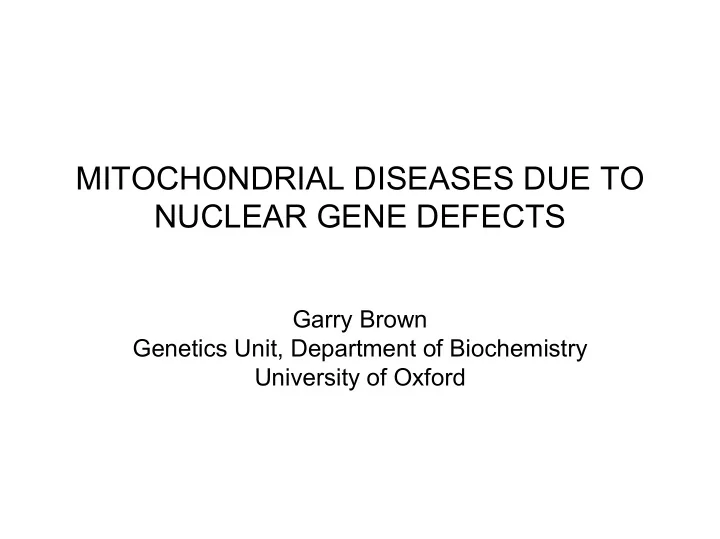

MITOCHONDRIAL DISEASES DUE TO NUCLEAR GENE DEFECTS Garry Brown Genetics Unit, Department of Biochemistry University of Oxford
FUNCTIONAL CLASSIFICATION • Mutations in genes for nuclear-encoded subunits of ETC complexes • Mutations in genes for ETC complex assembly factors • Mutations in genes involved in maintaining the structural integrity of mtDNA • Mutations in genes involved in maintaining mtDNA copy number • Mutations in genes involved in mitochondrial gene expression
COMPLEX I DEFICIENCY • Most common of the nuclear ETC defects • 39 of the 46 subunits are encoded by nuclear genes • Mutations now identified in NDUFS1, 2, 4, 7, 8 and NDUFV1 • Most present as Leigh or “Leigh-like” neurodegenerative disease • Associated findings include lactic acidosis, hypertrophic cardiomyopathy, renal tubular defects, liver disease, leukodystrophy, myoclonic epilepsy, • Enzyme activity in fibroblasts very variable, often normal
COMPLEX II DEFICIENCY • Four subunits, all encoded in the nucleus • SDHA mutations in patients with Leigh syndrome or late onset optic atrophy and myopathy • Mutations in SDHC and D associated with autosomal dominant hereditary paraganglioma • Mutations in SDHB and D in patients with familial phaeochromocytoma
COMPLEX ASSEMBLY DEFECTS • Most commonly associated with cytochrome oxidase deficiency • Most cases of systemic COX deficiency are due to mutations in SURF1 and present with typical Leigh syndrome • One common SURF1 mutation accounts for significant proportion of cases • Other COX assembly defects may have associated features, but unclear whether there are consistent patterns as few patients have been described in most cases
SURF1 Ins AT, del TCTGCCAGCC MUTATION IN EXON 4 • 30 of the first 65 mutant SURF1 alleles identified • In 22 unrelated families, homozygous in 8 • Always associated with 2 intragenic polymorphisms, T280C (L94L) and C573G (T191T) • Appears to be of (Northern) European origin
COX ASSEMBLY GENE DEFECTS Lactic Age at Brain Muscle Heart Liver Kidney acidosis onset Leigh SURF1 yes delayed hypotonia no no no syndrome proximal COX10 yes delayed non-specific hypotonia no no tubular disease liver SCO1 yes neonatal non-specific hypotonia no disease hypertrophic encephal- SCO2 yes neonatal hypotonia cardio- no no opathy myopathy hypertrophic Leigh syndrome/ COX15 yes neonatal hypotonia cardio- no no non-specific myopathy
OTHER ASSEMBLY DEFECTS COMPLEX III • Mutations in BCS1L , a gene encoding an AAA ATPase protein which acts as a chaperone for the Rieske iron- sulphur subunit • Patients have presented with encephalopathy, renal tubular and liver dysfunction • Defect not detected in cultured fibroblasts
COMPLEX V – ATP SYNTHASE • One patient described with a mutation in ATP12, a gene necessary for assembly of the F1 component of ATP synthase • Presented with lactic acidosis, encephalopathy, liver and kidney abnormalities • Reduced Complex V activity in liver, reduced activity in BN-PAGE gels for both liver and fibroblasts, no significant deficiency in muscle
DEFECTS IN mtDNA STABILITY MULTIPLE mtDNA DELETIONS • Most common is autosomal dominant progressive external ophthalmoplegia • Onset usually during adulthood • Multiple mtDNA deletions seen on Southern blot of muscle, not in rapidly dividing cells • Several associated gene defects – ANT1 , Twinkle and POLG – affect mitochondrial DNA replication and dNTP pools
RECESSIVE FORMS OF MULTIPLE mtDNA DELETION • SANDO – sensory ataxia, neuropathy, dysarthria and ophthalmoplegia – associated with POLG mutations (and perhaps TWINKLE) • ARCO – autosomal recessive cardiomyopathy and ophthalmoplegia – gene defect unknown
MAINTENANCE OF mtDNA COPY NUMBER – mtDNA DEPLETION MYOPATHIC FORM • Isolated myopathy - normal activity of Complex II in muscle, other complexes deficient • Mutations in mitochonrial thymidine kinase ( TK2 ) gene HEPATOCEREBRAL FORM • Early onset liver disease, lactic acidosis and encephalopathy – similar biochemical findings, but restricted to liver • Mutations in deoxyguanosine kinase ( DGUOK ) gene
ENCEPHALOPATHIC FORM • Grossly delayed development, hypotonia, seizures and deafness • Leigh-like changes in basal ganglia • Reduced complex I and IV activity in muscle, normal in fibroblasts • Mutation in SUCLA2, gene for β subunit of succinyl CoA synthetase • Associates with nucleoside diphosphate kinase in mitochondrion, mechanism of interference with mtDNA copy number unknown
MITOCHONDRIAL NEUROGASTROINTESTINAL ENCEPHALOMYOPATHY - MNGIE • White matter disease, ptosis, PEO, gut dysmotility and peripheral neuropathy • mtDNA depletion in all cases, multiple mtDNA deletions in a proportion • Increased blood and urine thymidine • Mutations in thymidine phosphorylase ( TP ) gene
ADP ANT1 ATP dNTP NDPK/ SUCLA2 TK2 TMP TdR dCMP dNDP dNMPK CdR AdR dAMP GdR dGMP GdRK DNC TdR GdR TP CdRK AdR dGMP CdR dNMPK dNDPK dAMP thymine dNDP dNTP dCMP TMP TK1
DEFECTS IN MITOCHONDRIAL GENE EXPRESSION Processing of mtDNA transcripts: • French-Canadian form of Leigh syndrome • Cytochrome oxidase deficiency, especially in brain, liver • Mutations in LRPPRC gene • Product is mRNA-binding protein
Defective tRNA pseudouridylation • Mitochondrial myopathy/sideroblastic anaemia syndrome • ETC defect in skeletal muscle and bone marrow • Mutation in PUS1 gene – required for synthesis of pseudouridine
Mitochondrial translation defects 1. Abnormal ribosomal protein • Fatal lactic acidosis, dysmorphism and cerebral malformation • Deficiency of Complexes I and IV in muscle, liver • Mutation in MRPS16 gene • Encodes a protein of the small subunit of the mitochondrial ribosome – secondary reduction in 12S rRNA
2. Deficient elongation factor • Early onset severe lactic acidosis, liver failure and encephalopathy with hypoplasia of the corpus callosum and basal ganglia lesions • Generalised ETC defect, especially of complexes I and IV and generalised translation defect • Mutation in EFG1 gene encoding a translation elongation factor
CURRENT POSITION • Increasing number of nuclear genetic defects being defined in patients with mitochondrial disease (especially with early onset) • Most account for very small number of patients • Clinical and biochemical features often overlapping and rather non-specific so difficult to define a single, simple path of investigation • Biochemical consequences of the defects may not be widely expressed – in particular, functional abnormalities are often not demonstrable in cultured fibroblasts
Recommend
More recommend